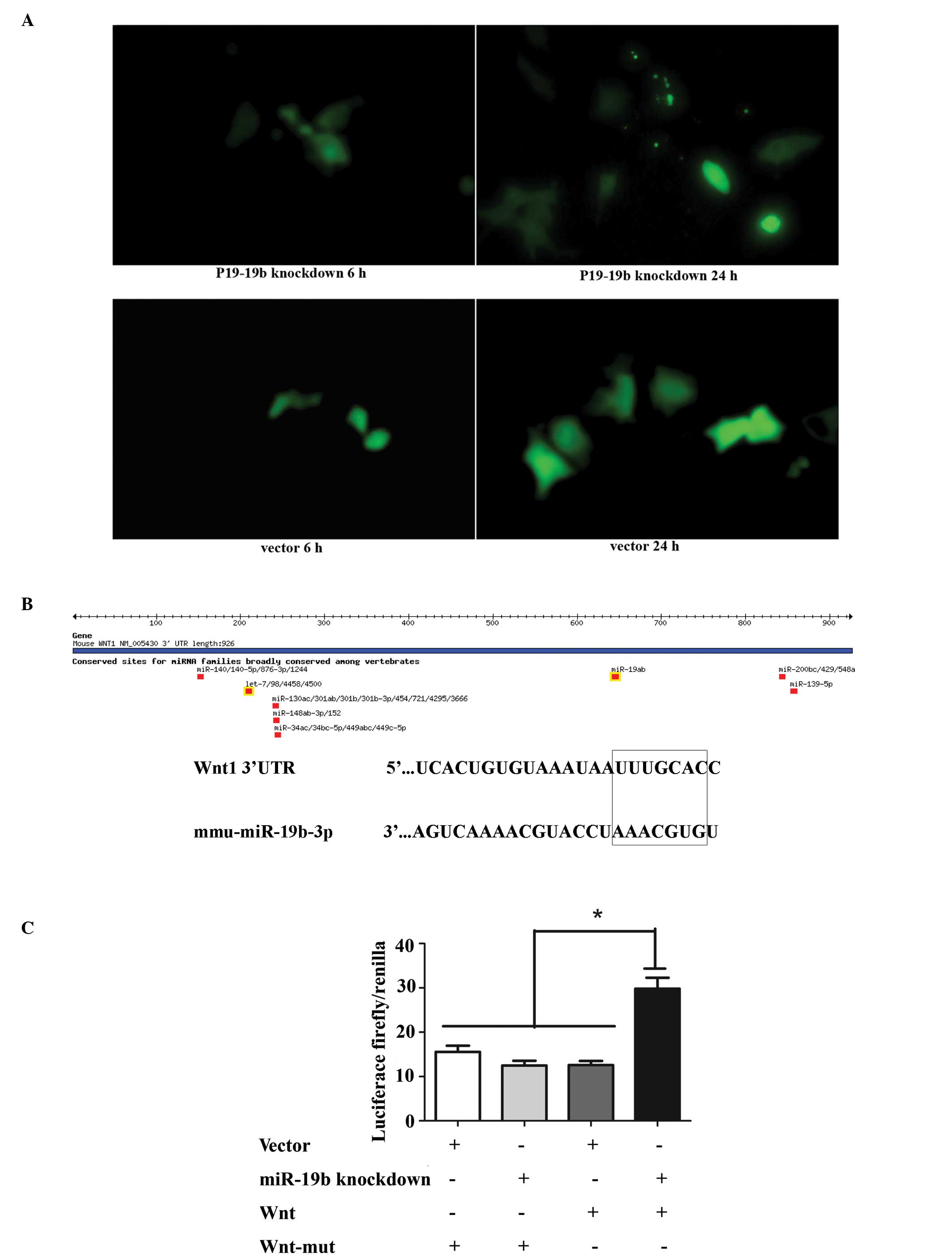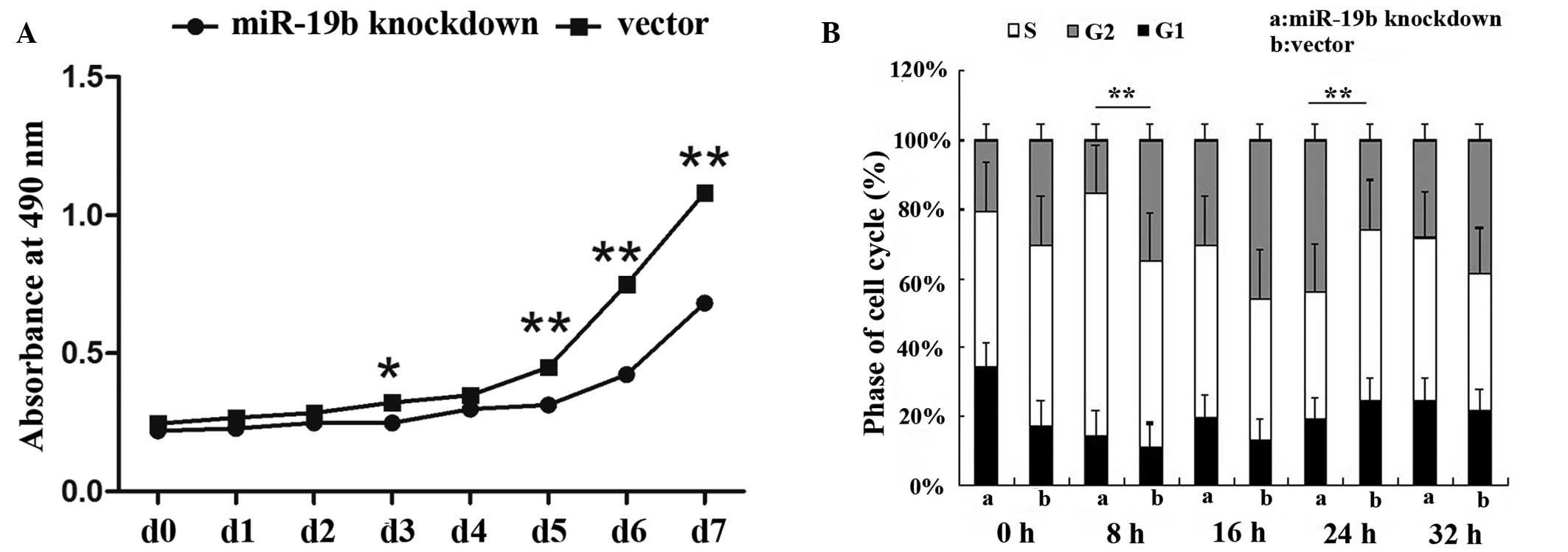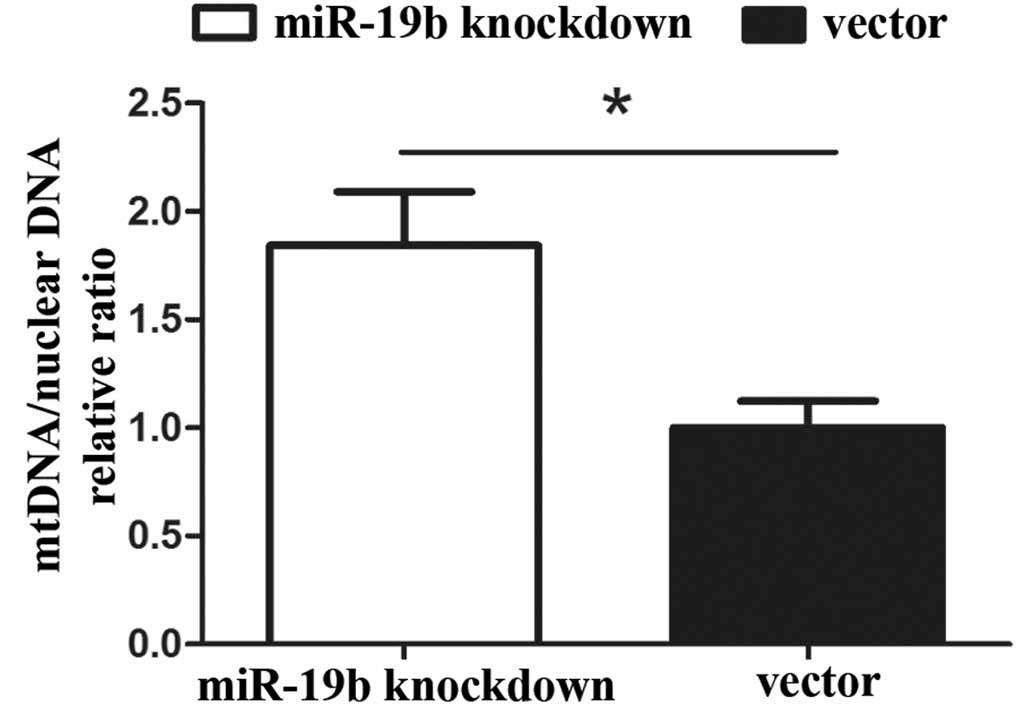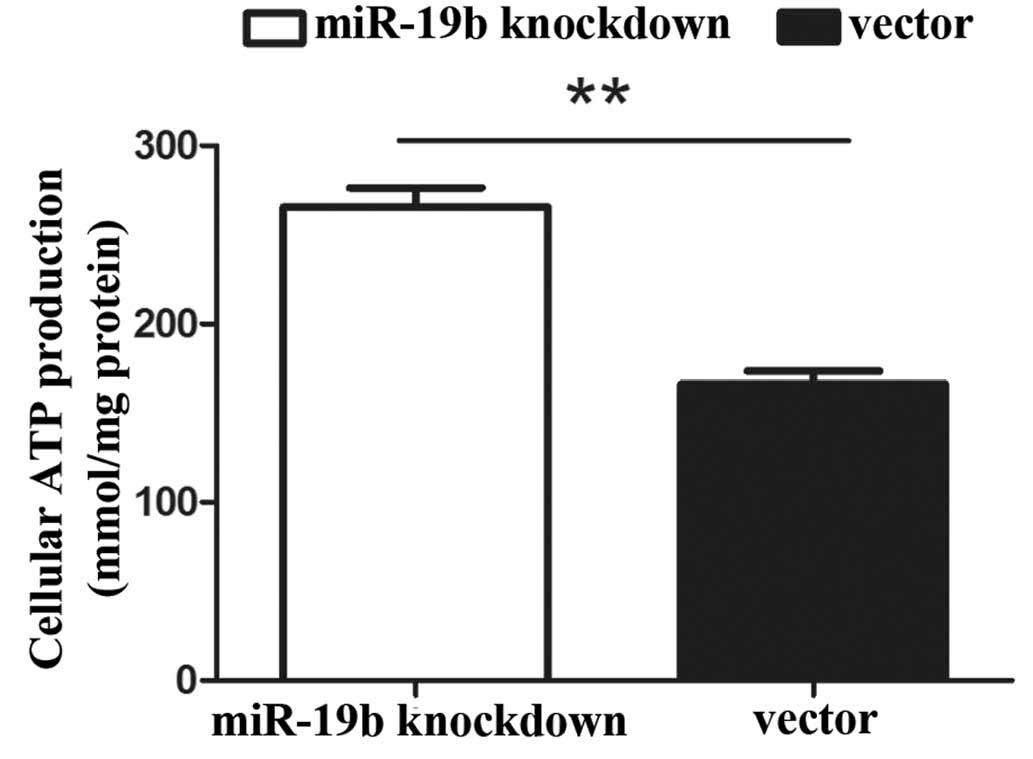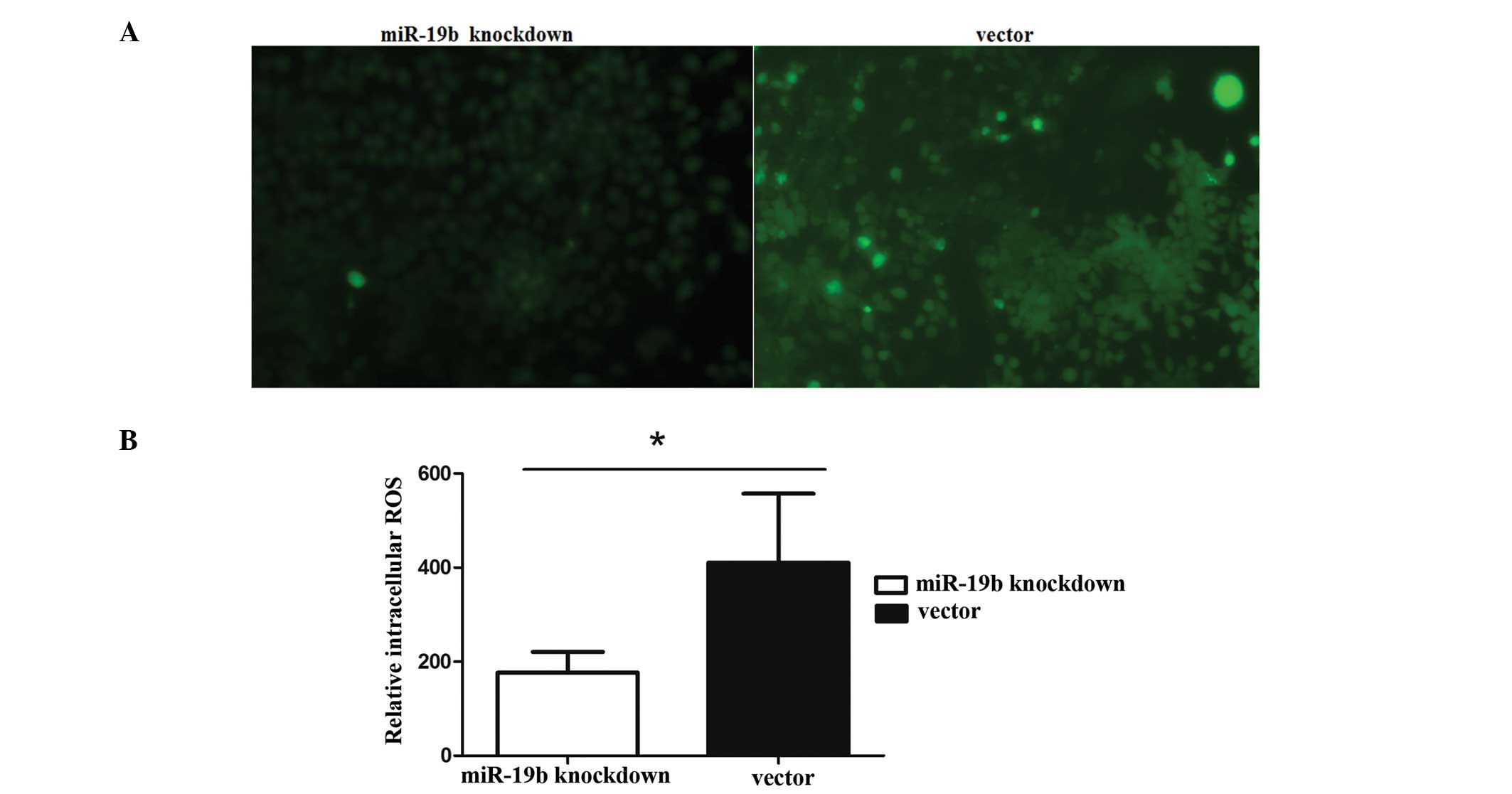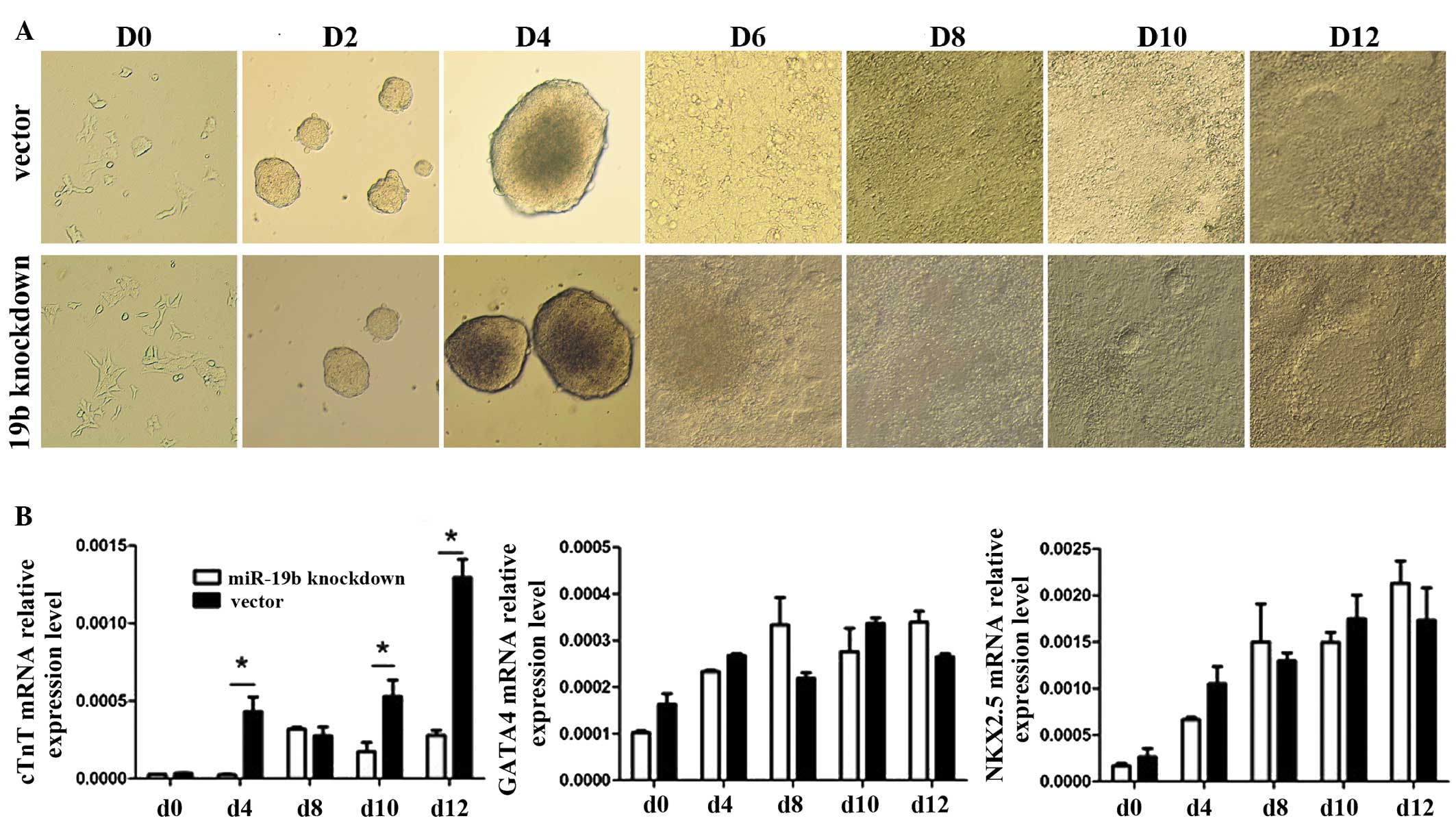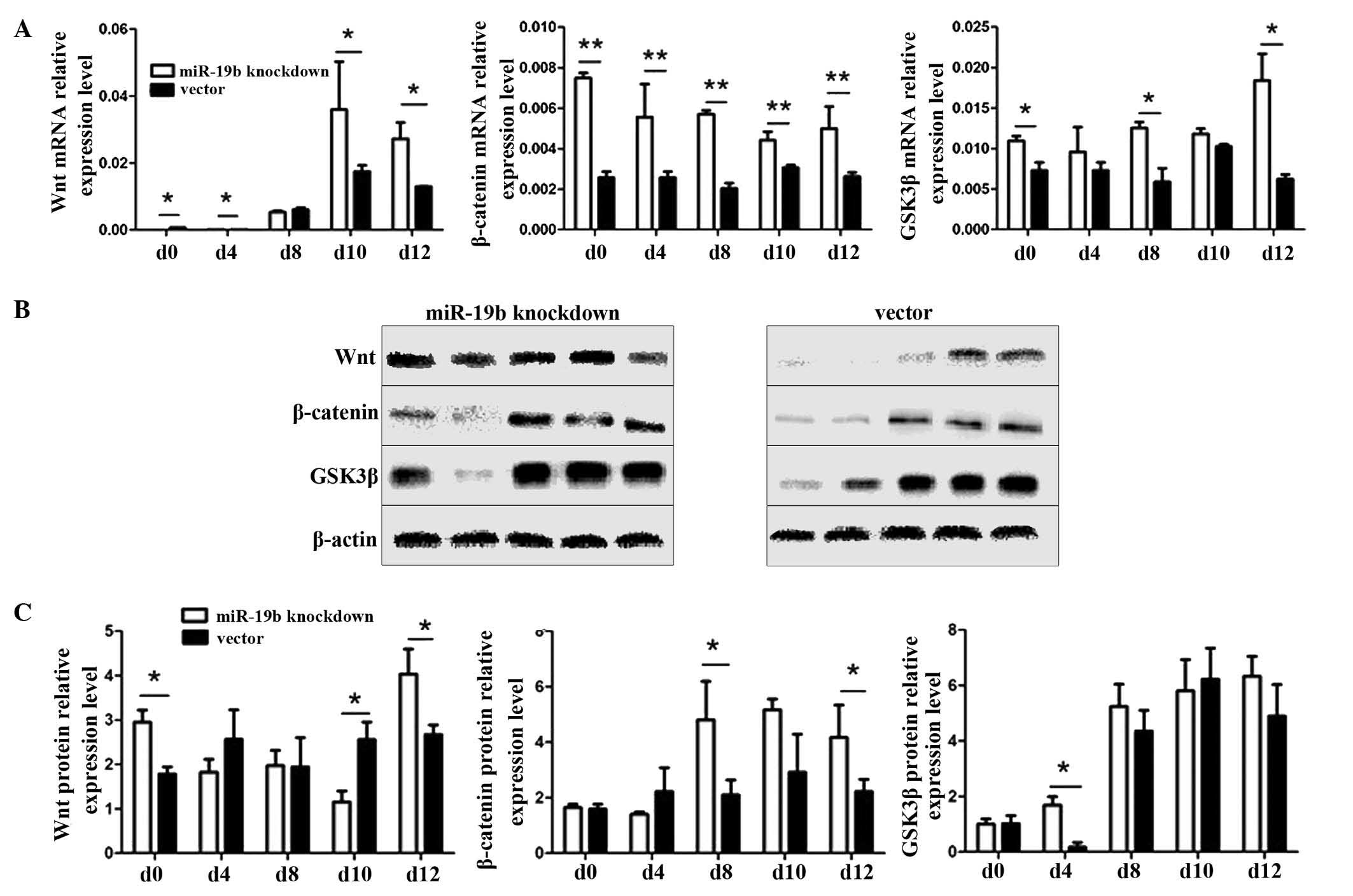Effects of miR-19b knockdown on the cardiac differentiation of P19 mouse embryonic carcinoma cells
Corrigendum in: /mmr/12/6/8328
- Authors:
- Published online on: December 3, 2014 https://doi.org/10.3892/mmr.2014.3037
- Pages: 2504-2512
-
Copyright: © Liu et al. This is an open access article distributed under the terms of Creative Commons Attribution License [CC BY_NC 3.0].
Abstract
Introduction
Congenital heart defects (CHD), which include malformations of the heart or great vessels, are the most common group of major birth defects, with an incidence of 5–8 per 1,000 live births (1). MicroRNAs (miRNAs) that contribute to cardiac development have been identified and can be used as novel biomarkers and therapeutic targets for CHD (2), as previously demonstrated with non-small cell lung cancer (3). MicroRNA-19b (miR-19b) is part of the miR-17–92 cluster, which encodes miR-17, miR-18a, miR-19a, miR-19b, miR-20a and miR-92a-1. The miR-17–92 cluster is required to induce cardiomyocyte proliferation in postnatal and adult hearts (4). A number of studies have shown that the miR-17–92 cluster contributes to the development of the heart, lungs, blood vessels and immune system (5). A previous study has observed specific changes in miRNA abundance and activity in a broad range of human aging models and suggested the use of miR-17, miR-19b, miR-20a and miR-106 as novel biomarkers of cellular aging (6).
P19 cells, isolated from an experimental embryo-derived mouse teratocarcinoma, differentiate into embryonic myocardial cells when exposed to dimethylsulfoxide (DMSO) (7). Therefore, they can be used to investigate cardiac-specific transcription factors and upstream signaling pathways during cardiac cell differentiation (8–10). In addition, P19 cells are an excellent model system for studying the regulation of myocardial electrophysiological differentiation at the molecular and functional levels (11).
The Wnt signaling pathway performs a number of functions during cardiogenesis (12). Early activation of Wnt/β-catenin signaling promotes cardiac differentiation in zebrafish embryos and mouse embryonic stem cells. Activation of Wnt/β-catenin at later stages results in the repression of cardiac differentiation (13). However, whether miR-19b knockdown affects the cardiac lineage commitment and differentiation through Wnt/β-catenin signaling remains to be determined.
As P19 cells can differentiate into cardiomyocytes, the present study investigated the underlying mechanisms of heart development by analyzing the proliferation, apoptosis and differentiation of P19 miR-19b-knockdown cells.
Materials and methods
Cell culture and induction of differentiation
P19 cells were obtained from the American Type Culture Collection (ATCC, Manassas, VA, USA). The cells were cultured in modified Eagle’s medium (α-MEM; Gibco-BRL, Grand Island, NY, USA) containing 10% fetal bovine serum (FBS; Gibco-BRL), 100 mg/ml streptomycin and 100 U/ml penicillin in a 5% CO2 atmosphere at 37°C. To induce cardiac differentiation, the cells were cultivated in 10 ml α-MEM supplemented with 10% FBS, 100 U/ml penicillin, 100 mg/ml streptomycin and 1% DMSO (Sigma, St. Louis, MO, USA) in 10-cm bacterial dishes in a 5% CO2 atmosphere at 37°C from days 0 to 4. On day 4, the embryoid bodies were transferred to 6-cm cell culture flasks with complete medium and cultured for an additional 8 days. Cells were harvested on differentiation days 0, 4, 8, 10 and 12. Morphological changes in the P19 cells were examined under an inverted microscope (Nikon Eclipse TE300; Nikon, Tokyo, Japan) equipped with phase-contrast objectives and a digital camera (E4500; Nikon). To investigate the differentiation process in P19 cells, quantitative polymerase chain reaction (qPCR) was used to identify the expression levels of cardiac troponin T (cTnT), GATA4 and NKX2.5 during differentiation.
MiRNA transfection and establishment of stable cell lines
Lipofectamine 2000 was used to transfect the plasmids (pGLV3/H1/eGFP/Puro-miR-19b-3p-inhibitor sponge and pGLV3/H1/eGFP/Puro-miR-vector; GenePharma, Shanghai, China) into P19 cells. Puromycin (Invitrogen, Carlsbad, CA, USA), which kills untransduced cells upon addition of the minimum concentration, was used to select stably transduced cells.
CCK-8 assay
Cell Counting kit-8 (CCK-8; Dojindo, Kumamoto, Japan) was used to assess cell growth according to the manufacturer’s instructions. The stable cell lines which were established with the miR-19b silencing expression plasmid or vector were seeded in 96-well plates and maintained in α-MEM supplemented with 10% FBS, 100 U/ml penicillin and 100 mg/ml streptomycin for seven consecutive days. In brief, the CCK-8 solution (10% of the medium, 10 μl) was added to each well and incubated for 1 h prior to analysis with a microplate reader (DNM-9602, Beijing Perlong Medical Instrument Ltd, Beijing, China) with the absorbance measured at a wavelength of 450 nm. The results were plotted as the mean ± standard deviation of three separate experiments, with three determinations per experiment for each experimental condition.
Cell cycle assay
MiR-19b silenced or vector control stable P19 cells were plated in α-MEM with 10% FBS, 100 U/ml penicillin and 100 mg/ml streptomycin. The cells were serum deprived for 24 h to synchronize them and, following replacement of the starvation medium with complete medium, were harvested using trypsin/EDTA, washed twice with phosphate-buffered saline (PBS), fixed in 70% ethanol at −20°C overnight and then stained with 500 ml propidium iodide (PI) solution (100 mg/ml RNase and 50 mg/ml PI in 1X PBS). Cell cycle analysis was initiated at multiple time points (0, 8, 16, 24 and 32 h). BD FACScan and Cell Quest software (BD Biosciences, San Jose, CA, USA) were used to analyze the labeled cultured cells.
Reverse transcription-quantitative polymerase chain reaction (RT-qPCR)
Total RNA was extracted from P19 cells using the TRIzol reagent and cDNA was synthesized from 1 μg of total RNA using the High Capacity cDNA Reverse Transcription kit. qPCR (Taqman method) was performed in a Sequence Detection System 7500 (Applied Biosystems Life Technologies, Foster City, CA, USA) according to the manufacturer’s instructions. All other materials including the Taqman dye and probes were obtained from Invitrogen. Briefly, the samples were incubated at 25°C for 10 min for the initial denatuation and subsequently subjected to 40 cycles of PCR, each consisting of 37°C for 120 min and 85°C for 5 min. The β-actin gene was used as a reference to obtain the relative fold change.
Flow cytometry
Cells were cultured in serum-deprived α-MEM for 24 h to induce apoptosis. Cells were harvested using trypsin/EDTA, washed with PBS, resuspended in 1 ml binding buffer, and stained with 10 μl Annexin V-fluorescein isothiocyanate (V-FITC) and 10 μl propidium iodide (PI) at room temperature for 15 min. Flow cytometry (Carl Zeiss LSM710; Carl Zeiss AG, Jena, Germany) was used to analyze the FITC (Annexin V:FITC Apoptosis Detection kit, BD Biosciences, San Diego, CA) and PI fluorescent (Becton, Dickinson and Company, Franklin Lakes, NJ, USA) signals.
Caspase-3 assay
A Caspase-3 Colorimetric Assay kit (KeyGen, Nanjing, China) was used to measure the caspase-3 activity according to the manufacturer’s instructions. Cells were cultured in serum-deprived α-MEM for 24 h to induce apoptosis, collected and washed with PBS. Briefly, cells were lysed on ice in lysis buffer for 1 h and vortexed every 20 min for 10 sec. This was followed by centrifugation for 1 min at 12,000 × g at 4°C. Aliquots of the supernatant containing 150 μg protein were diluted to 50 μl with cell lysis buffer, incubated with 5 μl of substrate at 37°C for 4 h in dark and a microplate reader (DNM-9602, Beijing Perlong Medical Instrument Ltd) was used to measure the absorbance value of the samples at 405 nm.
Determination of the mitochondrial DNA (mtDNA) levels
qPCR was used to determine the relative amounts of mtDNA. qPCR (Taqman method) was performed in the Sequence Detection System 7500 (Applied Biosystems Life Technologies) following the manufacturer’s instructions. Briefly, a DNA extraction kit (Promega, Madison, WI, USA) was used to isolate the DNA from the cells on the tenth day of differentiation. Spectrophotometry at a wavelength of 260 nm was employed to quantify the DNA. A 110-nt mtDNA fragment within the CYTB gene was used to quantify mtDNA. A 291-bp region of the nuclear 28S gene was used to normalize the results. The ratio of mtDNA to nuclear DNA reflected the concentration of mitochondria per cell.
Assessment of cellular ATP production
On the tenth day of differentiation, a luciferase-based luminescence assay kit (Beyotime, Nantong, China) was used to measure the ATP content of the P19 cells. Differentiated P19 cells were homogenized in an ice-cold ATP-releasing buffer and a single-tube luminometer (utrao SM600; Beyotime) was used to determine the ATP concentrations, which were normalized to the protein concentrations.
Assessment of intracellular reactive oxygen species (ROS) levels
A 2′,7′-dichlorodihydrofluorescein diacetate acetyl ester (H2-DCFDA) probe (Beyotime) was used to estimate the intracellular ROS levels. The cells were incubated with 5 μM of H2-DCFDA for 30 min at 37°C, washed three times with pre-warmed PBS and then observed with a confocal laser-scanning microscope (excitation at a wavelength of 579 nm, emission at 644 nm, ×400 magnification; E4500; Nikon). Subsequently, the cells were trypsinized and centrifuged at 1,500 × g at room temperature for 5 min, washed twice with PBS, resuspended in PBS and analyzed by flow cytometry (Becton, Dickenson and Company).
Antibodies and western blot analysis
Cultured cells were directly transferred to tubes containing lysis buffer and vortexed briefly. The supernatant was collected following centrifugation at 15,200 × g for 15 min at 4°C. Protein concentrations were determined using BCA protein assay reagent kit (KeyGen, Nanjing, China). Total proteins were isolated from cultured cells, separated on a 10% sodium dodecyl sulfate (SDS) gel by SDS polyacrylamide gel electrophoresis, and transferred onto polyvinylidene difluor-ide membranes. These membranes were incubated with a mouse polyclonal anti-WNT1, mouse monoclonal anti-GSK3β, rabbit polyclonal anti-β-catenin and mouse anti-β-actin antibody (Affinity, Santa Cruz, CA, USA), and goat anti-rabbit or rabbit anti-mouse immunoglobulin G–horseradish peroxidase conjugate (Amersham, UK). Immunoreactive proteins were detected by enhanced chemi-luminescence (Amersham, UK).
Luciferase assay
The recombinant vector or pGL3-Basic vector (GenePharma, Shanghai, China) were cotransfected with the pRL-CMV vector (GenePharma) containing a Renilla luciferase reporter gene (as a normalizing control) into either the miR-19b knockdown or control stable P19 cells. The Dual Luciferase Reporter Assay system (Promega) was used to analyze the firefly and Renilla luciferase activities 36 h later.
Statistical analysis
Each experiment was performed with at least 3 different cultures and repeated at least 3 times. Data are presented as the mean ± standard deviation (SD). For comparison of differences between groups, analysis of variance and unpaired Student’s t-tests were used. P<0.05 was considered to indicate a statistically significant difference.
Results
Transfection of P19 cells with the miR-19b knockdown vector
Plasmids pGLV3/H1/eGFP/Puro-miR-19b-3p-inhibitor sponge and pGLV3/H1/eGFP/Puro-miR-vector were transiently transfected into P19 cells. Observation of green fluorescent protein (GFP) expression under a fluorescence microscope indicated similar transfection efficiencies (Fig. 1A). Subsequently, stably transfected cells were selected by puromycin. Interaction between miRNAs and their target site(s) in the 3′ untranslated regions (3′-UTRs) results in translational repression or miRNA cleavage. Once the miRNAs are inhibited, the target gene becomes free from transcriptional repression and is activated, which can be detected by luciferase activity. In order to knockdown miR-19b (5′-UGUGCAAAUCCAUGCAAAACUGA-3′), complementary binding sites (5′-TCAGTTTTGCATGGATT TGCACA-3′) were inverted into the plasmid which were perfectly complementary with the sponge RNA (5′-GATCCT CAGTTTTGCATGGATTTGCACACTAGTCAGTTTTGCA TGGATTTGCACATTACCATCAGTTTTGCATGGATTTG CACAGAATTCAGTTTTGCATGGATTTGCACATTTTTT GAATT-3′). Previous studies have confirmed that the 3′-UTR of Wnt1 is a target of miR-19b. As expected, miR-19b knockdown significantly rescued the luciferase activity of the pGL3-wnt-3′-UTR reporter but not the mutated construct (mu-pGL3-Wnt-′3-UTR) (Fig. 1B and C; P<0.01). The result of the luciferase activity assay indirectly revealed that miR-19b was knocked down, demonstrating that the miR-19b-knockdown vector was constructed successfully.
miR-19b knockdown inhibits cellular proliferation
The CCK-8 assay was used to assess the growth of miR-19b-knockdown and control P19 cells. At days 1, 2 and 4, the optical density (OD) values of the miR-19b-knockdown and control cells showed no significant differences. However, at days 5, 6 and 7, the OD values of the miR-19b-knockdown cells were significantly lower than those of the control cells. Thus, a reduced growth rate of the miR-19b-knockdown cells was observed compared with that observed in the control cells (Fig. 2A; P<0.05 and P<0.01). In addition, miR-19b-knockdown also affected the cell cycle. Flow cytometry of the cell cycle distribution detected a significantly lower percentage of miR-19b-knockdown P19 cells in the S phase of the cell cycle compared with that of the control cells (Fig. 2B; P<0.01).
MiR-19b knockdown reduces the levels of apoptosis in P19 cells
Caspase-3 protein assays and Annexin V-FITC, which binds to phosphatidylserine, were used to detect the early stages of apoptosis. Cells were induced to undergo apoptosis via 24 h of serum starvation. Binding experiments with Annexin V-FITC indicated that miR-19b knockdown reduced the number of apoptotic cells in response to serum deprivation (Fig. 3A; P<0.05). Additionally, the caspase-3 activity assay (Fig. 3B; P<0.01) revealed that miR-19b knockdown reduced the number of apoptotic cells in response to serum deprivation. These results indicate that miR-19b knockdown inhibits serum deprivation-induced apoptosis in P19 cells.
Effects of miR-19b knockdown on mtDNA copy number in P19 cells
The relative expression levels of mitochondria were assessed, as these represent the total mtDNA copy number in the two cell lines. The mtDNA copy number per mitochondrion is considered to be constant in all mammalian cell types. As a result, the copy number of mtDNA can be determined from the relative quantity of mitochondria. qPCR revealed that the mtDNA copy number was significantly higher in the miR-19b knockdown group compared with that in the vector group (Fig. 4; P<0.05).
Cellular ATP production increases upon miR-19b knockdown
In eukaryotic cells, the mitochondrion is the major platform for energy transduction, producing ATP via the oxidative metabolism of nutrients. Impaired mitochondria may lead to a reduction in the levels of ATP. The results of the current study revealed that the total cellular production levels of ATP were increased in the miR-19b knockdown cells compared with those in the control cells (Fig. 5; P<0.01).
Effects of miR-19b knockdown on intracellular ROS levels
Subsequently, the effect of miR-19b knockdown on the ROS content of cells was investigated. The levels of ROS in the miR-19b-knockdown cells were much lower than those in the control cells (Fig. 6A), as indicated by less intense fluorescent signals in the presence of the H2-DCFDA (Fig. 6B). Hence, the results clearly demonstrate that miR-19b knockdown inhibits apoptosis, accompanied by mitochondrial dysfunction in P19 cells.
MiR-19b knockdown has no clear effect on the morphology of P19 cells during differentiation
To investigate the ability of the miR-19b-knockdown P19 cells to differentiate into myocardial cells, the morphological appearance was observed and myocardial-specific molecular markers (cTnT, GATA4 and NKX2.5) were quantified, and the appearance of beating cell clusters during DMSO-induced differentiation was monitored (Fig. 7A). However, no differences were observed in the cell morphology or the time taken for the appearance of beating cell clusters between the miR-19b-knockdown cells and the control cells. In addition to observing cell morphology, the expression of myocardial-specific molecular markers was analyzed at the RNA level, including cTnI, GATA4 and NKX2.5, which are known to have upregulated levels of expression during the differentiation of mouse P19 cells into myocardial cells (Fig. 7B; P<0.05). The expression levels of these marker genes were detected by RT-qPCR in the two cell lines on days 0, 4, 8, 10 and 12. Expression levels of all the marker genes gradually increased during the process of differentiation, however, in the miR-19b-knockdown cells only cTnT showed significantly lower expression levels compared with those observed in the control cells at days 4, 10 and 12.
Effect of miR-19b knockdown on the Wnt/β-catenin signaling pathway
Wnt is an essential regulator of cell differentiation. The Wnt protein initiates the Wnt/β-catenin signaling pathway, GSK3β acts as a switch and β-catenin functions as the effector molecule. Therefore, qPCR and western blot analyses were used to detect the RNA and protein expression changes of several key molecules in the Wnt signaling pathway (Wnt, GSK3β and β-catenin). During the induction of differentiation of P19 cells into myocardial cells, the relative expression levels of Wnt, GSK3β and β-catenin were significantly higher compared with those in the vector group at almost all time points (Fig. 8A; P<0.05 and P<0.01). At the protein level, the expression levels of Wnt in the miR-19b-knockdown group were significantly higher than those in the vector group at days 0, 10 and 12, those of β-catenin were significantly higher than those in the vector group at days 8 and 12, those of GSK3β were significantly higher than those in the vector group at day 4, and the trend in the levels of β-catenin expression was similar to that of Wnt1 (Fig. 8B and C, P<0.05).
Discussion
MiRNAs contribute to cardiac development and can be used as novel biomarkers and therapeutic targets for CHDs (2,14). Previous studies have determined that the miR-17–92 cluster, which includes mir-19b, is important in a number of diseases and miR-19b expression may correlate with the incidence of cardiovascular diseases and cardiogenesis (15). Gao et al (16) found that the downregulation of miR-19b contributes to angiotensin II-induced overexpression of connective tissue growth factor in cardiomyocytes. Jung et al (17) determined that there is an interaction between the hepatitis B virus (HBV) and the miR-17–92 polycistron via c-Myc, and that miR-20a and miR-92a-1 induce post-transcriptional suppression of HBV. In the present study, the P19 cell line was used as a research model, and a stable line of miR-19b-knockdown P19 cells was established to evaluate the effect of this miRNA on P19 cells and their differentiation toward myocardial cells. MiR-19b knockdown inhibited proliferation and apoptosis in the P19 cells. Notably, a previous study found that the overexpression of miR-19b could increase proliferation, inhibit apoptosis and promote differentiation of P19 cells into mature cardiac cells (18). This indicates that overexpression of miR-19b or miR-19b knockdown may influence morphogenesis in the embryonic heart by inhibiting excessive apoptosis in the myocardium. Embryonic fetal heart growth depends on the balance between cardiomyocyte proliferation and apoptosis (19). Inadequate proliferation or excess apoptosis may directly or indirectly result in CHD (20), which is often caused by altered proliferation and/or apoptosis in the septum, neighboring tissue or myocardium (21).
The results of the present study, including those from the CCK-8 assay and cell cycle analysis, indicate that miR-19b knockdown inhibits the proliferation of P19 cells by significantly reducing the percentage of cells in the S phase, however, the specific mechanism by which this occurs remains to be determined. Yan et al (22) determined that overexpression of the miR-17–92 cluster markedly inhibited hypoxia-induced apoptosis. Sharifi et al (23) found that inhibition of miR-92a inhibited cell proliferation in human acute promyelocytic leukemia. In the current study, miR-19b knockdown was determined to significantly inhibit serum starvation-induced apoptosis. The molecular mechanism that underlies this effect remains unknown. Crow et al (24) hypothesized that mitochondria are important in the transmission and amplification of apoptotic signals. Mitochondria are at the center of the regulatory processes for apoptosis (25). In the present study, it was demonstrated that levels of intracellular ROS were reduced, ATP contents were increased and the levels of mitochondrial DNA were increased on the tenth day of differentiation of P19 cells. It may be hypothesized that miR-19b knockdown cells generate more ATP to compensate for lost ATP production, which correlates with the increased level of mitochondrial DNA. It was observed that miR-19b knockdown does not significantly affect the differentiation of P19 cells into cardiomyocytes, indicated by the lack of morphological changes and the normal expression of cardiomyogenesis-specific molecular markers. Although the expression of all the marker genes (cTnT, GATA4 and NKX2.5) gradually increased during differentiation, only cTnT in miR-19b-knockdown cells showed significantly lower expression levels than those in the control cells at days 4, 10 and 12.
Furthermore, the results of the present study demonstrate that miR-19b does affect the Wnt/β-catenin signaling pathway. Wnt signaling is an essential regulator of cardiovascular differentiation, morphogenesis and progenitor self-renewal (26). Given that miRNAs negatively regulate their targets, miR-19b knockdown should upregulate its potential targets. A previous study revealed that miR-19b may indirectly target Wnt1 mRNA through its 3′-UTR (16). In the present study, the results of the luciferase assay indicate that miR-19b knockdown rescued Wnt1 expression by removing its interaction with its cognate miRNA. Wnts were initially considered suppressive of heart formation. Wnts 1, 3A and 8 act via the inhibition of GSK3, allowing nuclear localization of β-catenin, which appears to inhibit cardiac differentiation, whereas the non-canonical Wnt11, along with protein kinase C, appears to enhance cardiac differentiation (27). Previous results in zebrafish indicate that β-catenin signaling is blocked in heart valve formation, which demonstrates a negative role of Wnts in heart development (28). In the present study, miR-19b knockdown affected differentiation by increasing the activation of the Wnt/β-catenin signaling pathway via an essential upstream target of Wnt1.
Furthermore, Wnt/β-catenin signaling can promote cardiogenesis by inducing the proliferation of cardiac progenitor cells in the secondary heart field (29–31). Wnt/β-catenin signaling is also important in the endocardium, where it regulates the specification and proliferation of endocardial cushion cells (32). In the present study, following the successful knockdown of miR-19b, which normally acts on the 3′-UTR of Wnt1, the levels of Wnt1 protein expression significantly increased, thereby activating Wnt/β-catenin signaling and inhibiting myocardial cell development.
Previous studies indicate that endogenous miR-19b may have a key regulatory role in constraining the production of pro-inflammatory cytokines and chemokines by fibroblast-like synoviocytes and hence contribute to the pathology of inflammation (33). MiR-19b is also a novel regulator of fibrotic TGF-β signaling and the loss of miR-19b following hepatic stellate cell (HSC) activation perpetuates the fibrotic response (34). Furthermore, the miR-19a/b family regulates cardiac hypertrophy and survival by repressing the target genes atrogin-1 and MuRF-1 (35).
In conclusion, the results of the present study demonstrate that miR-19b knockdown significantly inhibits the proliferation and apoptosis of P19 cells. MiR-19b knockdown results in an increase in Wnt expression levels, which activates the Wnt/β-catenin signaling pathway in P19 cells, and may regulate the cardiomyocyte differentiation of P19 cells. These results indicate that miR-19b overexpression and knockdown leads to an imbalance between proliferation and apoptosis, which may result in embryonic cardiac malformations. This study of miR-19b provides insight into novel therapeutic strategies for CHD. Further study into the functions of related miRNAs may elucidate the processes of pathogenesis during cardiogenesis. However, the molecular mechanisms that mediate the balance between proliferation and apoptosis in response to miR-19b knockdown or overexpression require further investigation.
Acknowledgements
This study was supported by grants from the National Natural Science Foundation of China (grant no. 81070500), the Key Medical Personnel Foundation of Jiangsu Province (grant no. RC2011021), the Nanjing Medical Science and Technique Development Foundation (grant no. QRX11107) and the Science and Technology Development Foundation of Nanjing Medical University (grant no. 2010NJMUZ15).
References
|
Capozzi G, Caputo S, Pizzuti R, Martina L, Santoro M, Santoro G, et al: Congenital heart disease in live-born children: incidence, distribution, and yearly changes in the Campania Region. J Cardiovasc Med (Hagerstown). 9:368–374. 2008. View Article : Google Scholar | |
|
Thum T, Catalucci D and Bauersachs J: MicroRNAs: novel regulators in cardiac development and disease. Cardiovasc Res. 79:562–570. 2008. View Article : Google Scholar : PubMed/NCBI | |
|
Wu C, Cao Y, He Z, He J, Hu C, Duan H and Jiang J: Serum levels of miR-19b and miR-146a as prognostic biomarkers for non-small cell lung cancer. Tohoku J Exp Med. 232:85–95. 2014. View Article : Google Scholar : PubMed/NCBI | |
|
Lu Y, Thomson JM, Wong HY, Hammond SM and Hogan BL: Transgenic over-expression of the microRNA miR-17–92 cluster promotes proliferation and inhibits differentiation of lung epithelial progenitor cells. Dev Biol. 310:442–453. 2007. View Article : Google Scholar : PubMed/NCBI | |
|
Boggs RM, Moody JA, Long CR, Tsai KL and Murphy KE: Identification, amplification and characterization of miR-17–92 from canine tissue. Gene. 404:25–30. 2007. View Article : Google Scholar : PubMed/NCBI | |
|
Hackl M, Brunner S, Fortschegger K, Schreiner C, Micutkova L, Mück C, Laschober GT, et al: miR-17, miR-19b, miR-20a, and miR-106a are down-regulated in human aging. Aging Cell. 9:291–296. 2010. View Article : Google Scholar : PubMed/NCBI | |
|
Skerjanc IS: Cardiac and skeletal muscle development in P19 embryonal carcinoma cells. Trends Cardiovasc Med. 9:139–143. 1999. View Article : Google Scholar | |
|
van der Heyden MA and Defize LH: Twenty one years of P19 cells: what an embryonal carcinoma cell line taught us about cardiomyocyte differentiation. Cardiovasc Res. 58:292–302. 2003. View Article : Google Scholar : PubMed/NCBI | |
|
van der Heyden MA, van Kempen MJ, Tsuji Y, Rook MB, Jongsma HJ and Opthof T: P19 embryonal carcinoma cells: a suitable model system for cardiac electrophysiological differentiation at the molecular and functional level. Cardiovasc Res. 58:410–422. 2003. View Article : Google Scholar : PubMed/NCBI | |
|
Han SP, Pan Y, Peng YZ, Gu XQ, Chen RH and Guo XR: Folbp1 promotes embryonic myocardial cell proliferation and apoptosis through the WNT signal transduction pathway. Int J Mol Med. 23:321–330. 2009.PubMed/NCBI | |
|
Hu DL, Chen FK, Liu YQ, Shen YH, Yang R, et al: GATA-4 promotes the differentiation of P19 cells into cardiac myocytes. Int J Mol Med. 26:365–372. 2010.PubMed/NCBI | |
|
Cohen ED, Tian Y and Morrisey EE: Wnt signaling: an essential regulator of cardiovascular differentiation, morphogenesis and progenitor self-renewal. Development. 135:789–798. 2008. View Article : Google Scholar : PubMed/NCBI | |
|
Ueno S, Weidinger G, Osugi T, Kohn AD, Golob JL, et al: Biphasic role for Wnt/beta-catenin signaling in cardiac specification in zebrafish and embryonic stem cells. Proc Natl Acad Sci USA. 104:9685–9690. 2007. View Article : Google Scholar : PubMed/NCBI | |
|
Zhu S, Cao L, Zhu J, Kong L, Jin J, Qian L, Zhu C, Hu X, Li M, Guo X, Han S and Yu Z: Identification of maternal serum microRNAs as novel non-invasive biomarkers for prenatal detection of fetal congenital heart defects. Clin Chim Acta. 424:66–72. 2013. View Article : Google Scholar : PubMed/NCBI | |
|
van Almen GC, Verhesen W, van Leeuwen RE, van de Vrie M, Eurlings C, et al: MicroRNA-18 and microRNA-19 regulate CTGF and TSP-1 expression in age-related heart failure. Aging Cell. 10:769–779. 2011. View Article : Google Scholar : PubMed/NCBI | |
|
Gao S, Liu TW, Wang Z, Jiao ZY, Cai J, Chi HJ and Yang XC: Downregulation of microRNA-19b contributes to angiotensin II-induced overexpression of connective tissue growth factor in cardiomyocytes. Cardiology. 127:114–120. 2014. View Article : Google Scholar | |
|
Jung YJ, Kim JW, Park SJ, Min BY, Jang ES, Kim NY, Jeong SH, Shin CM, Lee SH, Park YS, Hwang JH, Kim N and Lee DH: c-Myc-mediated overexpression of miR-17–92 suppresses replication of hepatitis B virus in human hepatoma cells. J Med Virol. 85:969–978. 2013. View Article : Google Scholar : PubMed/NCBI | |
|
Qin DN, Qian L, Hu DL, Yu ZB, Han SP, Zhu C, Wang X and Hu X: Effects of miR-19b overexpression on proliferation, differentiation, apoptosis and Wnt/β-catenin signaling pathway in P19 cell model of cardiac differentiation in vitro. Cell Biochem Biophys. 66:709–722. 2013. View Article : Google Scholar : PubMed/NCBI | |
|
Fiorina P, Corradi D, Pinelli S, Maestri R, Lagrasta C, Buscaglia M, et al: Apoptotic/mytogenic pathways during human heart development. Int J Cardiol. 96:409–417. 2004. View Article : Google Scholar : PubMed/NCBI | |
|
Lévy M, Maurey C, Celermajer DS, Vouhé PR, Danel C, Bonnet D and Israël-Biet D: Impaired apoptosis of pulmonary endothelial cells is associated with intimal proliferation and irreversibility of pulmonary hypertension in congenital heart disease. J Am Coll Cardiol. 49:803–810. 2007. View Article : Google Scholar : PubMed/NCBI | |
|
Gittenberger-de Groot GA, Bartelings MM, Deruiter MC and Poelmann RE: Basics of cardiac development for the understanding of congenital heart malformations. Pediatr Res. 57:169–176. 2005. View Article : Google Scholar | |
|
Yan HL, Xue G, Mei Q, Wang YZ, Ding FX, Liu MF, et al: Repression of the miR-17–92 cluster by p53 has an important function in hypoxia-induced apoptosis. EMBO J. 28:2719–2732. 2009. View Article : Google Scholar : PubMed/NCBI | |
|
Sharifi M, Salehi R, Gheisari Y and Kazemi M: Inhibition of MicroRNA miR-92a inhibits cell proliferation in human acute promyelocytic leukemia. Turk J Hematol. 30:157–162. 2013. View Article : Google Scholar | |
|
Crow MT, Mani K, Nam YJ and Kitsis RN: The mitochondrial death pathway and cardiac myocyte apoptosis. Circ Res. 95:957–970. 2004. View Article : Google Scholar : PubMed/NCBI | |
|
Brooks C and Dong Z: Regulation of mitochondrial morphological dynamics during apoptosis by Bcl-2 family proteins: a key in Bak? Cell Cycle. 6:3043–3047. 2007. View Article : Google Scholar : PubMed/NCBI | |
|
Cohen ED, Tian Y and Morrisey EE: Wnt signaling: an essential regulator of cardiovascular differentiation, morphogenesis and progenitor self-renewal. Development. 135:789–798. 2008. View Article : Google Scholar : PubMed/NCBI | |
|
Olson EN and Schneider MD: Sizing up the heart: development redux in disease. Genes Dev. 17:1937–1956. 2003. View Article : Google Scholar : PubMed/NCBI | |
|
Hurlstone AF, Haramis AP, Wienholds E, Begthel H, Korving J, Van Eeden F, et al: The Wnt/beta-catenin pathway regulates cardiac valve formation. Nature. 425:633–637. 2003. View Article : Google Scholar : PubMed/NCBI | |
|
Verhoeven MC, Haase C, Christoffels VM, Weidinger G and Bakkers J: Wnt Signaling Regulates Atrioventricular Canal Formation Upstream of BMP and Tbx2. Birth Defect Res A Clin Mol Teratol. 91:435–440. 2011. View Article : Google Scholar | |
|
Ai D, Fu X, Wang J, Lu MF, Chen L, Baldini A, et al: Canonical Wnt signaling functions in second heart field to promote right ventricular growth. Proc Natl Acad Sci USA. 104:9319–9324. 2007. View Article : Google Scholar : PubMed/NCBI | |
|
Kwon C, Arnold J, Hsiao EC, Taketo MM, Conklin BR and Srivastava D: Canonical Wnt signaling is a positive regulator of mammalian cardiac progenitors. Proc Natl Acad Sci USA. 104:10894–10899. 2007. View Article : Google Scholar : PubMed/NCBI | |
|
Cai X, Zhang W, Hu J, Zhang L, Sultana N, Wu B, Cai W, Zhou B and Cai CL: Tbx20 acts upstream of Wnt signaling to regulate endocardial cushion formation and valve remodeling during mouse cardiogenesis. Development. 140:3176–3187. 2013. View Article : Google Scholar : PubMed/NCBI | |
|
Gantier MP, Stunden HJ, McCoy CE, Behlke MA, Wang D, Kaparakis-Liaskos M, Sarvestani ST, Yang YH, Xu D, Corr SC, Morand EF and Williams BR: A miR-19 regulon that controls NF-iB signaling. Nucleic Acids Res. 40:8048–8058. 2012. View Article : Google Scholar : PubMed/NCBI | |
|
Lakner AM, Steuerwald NM, Walling TL, Ghosh S, Li T, McKillop IH, Russo MW, Bonkovsky HL and Schrum LW: Inhibitory effects of microRNA 19b in hepatic stellate cell-mediated fibrogenesis. Hepatology. 56:300–310. 2012. View Article : Google Scholar : PubMed/NCBI | |
|
Song DW, Ryu JY, Kim JO, Kwon EJ and Kim do H: The miR-19a/bfamily positively regulates cardiomyocyte hypertrophy by targeting atrogin-1 and MuRF-1. Biochem J. 457:151–162. 2014. View Article : Google Scholar |



